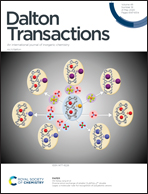CO, NO, and SO adsorption on Ni nanoclusters: a DFT investigation†
Abstract
Nickel nanoclusters are very promising for catalysis-related applications, especially involving chemical reactions with polluting molecules, such as carbon, nitrogen, and sulfur monoxides, which are directly or indirectly involved in serious environmental pollution problems. Therefore, it is of utmost importance to improve the understanding of the interaction between Ni nanoclusters and diatomic molecules, such as CO, NO, and SO, to provide insights into real subnano catalysts. Thus, here, we report an ab initio investigation based on density functional theory calculations within van der Waals D3 corrections to investigate the adsorption properties of CO, NO, and SO on Ni nanoclusters. From energetic and electronic criteria applied to Nin nanoclusters (n = 2–15), we selected Ni6 (octahedron) and Ni10 (triangular pyramid) nanoclusters as supports. According to our analyses, the molecular adsorption increases the stability of Ni nanoclusters, especially for Ni6 systems. The interaction intensity is larger for SO than for NO and CO in adsorbed systems, and the strong OS–Ni interaction is responsible for the well-known sulfur poisoning on transition-metal systems. The lowest energy adsorption sites are onefold for CO/Ni6, NO/Ni6, and CO/Ni10; twofold for NO/Ni10; and threefold for SO/Ni6 and CO/Ni10, where CO and NO molecules sustain linear and perpendicular geometries, while SO geometry changes to a bent configuration resulting from a sideways adsorption. The equilibrium bond lengths of the molecules expand upon adsorption, from 0.9% (NO/Ni6/10) to 11.3% (SO/Ni6/10), consequently, the internal molecular bond strengths decrease, since there is a reduction in the molecular stretching frequencies. This result occurs most strongly for SO followed by NO and CO systems, which was confirmed by an estimation of the energetic contribution of the distortion after the adsorption process. Thus, the strong S–Ni interaction, given by SO chemisorption on hollow sites with a sideways interaction, implies an energetic decrease and, consequently, a part of the energy gained from the SO–Ni interaction is from the SO and nanocluster distortions. Ultimately, using the energy decomposition analysis (from SAPT0) for XO/Ni6 systems, we improved the understanding of the CO and NO (SO) singlet (doublet) spin multiplicities’ interaction with Ni6 nanoclusters.



 Please wait while we load your content...
Please wait while we load your content...